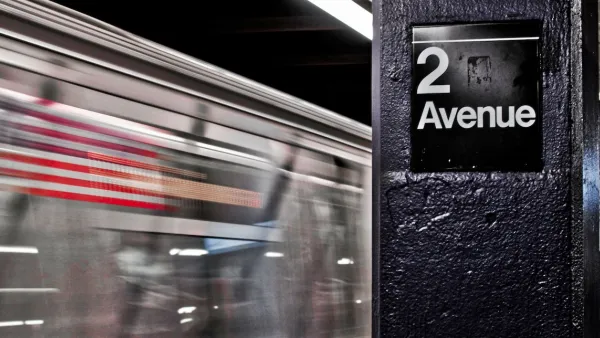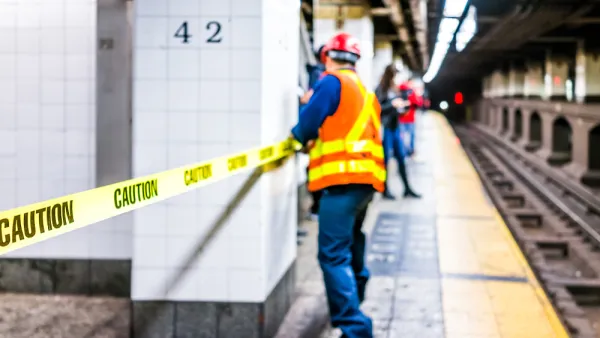One of the most important officials in New York State transportation history died Oct. 15: William J. Ronan, who took on Robert Moses to form the country's largest, most diversified transportation agency, the Metropolitan Transportation Authority.
"With the blessing of Gov. Nelson A. Rockefeller, whom he long served as a close aide and adviser, Dr. Ronan engineered the state’s takeover of the Long Island Rail Road [from the Pennsylvania Railroad] and then outmaneuvered Robert Moses, the master builder of highways, bridges and parks, to secure the takeover of the Triborough Bridge and Tunnel Authority and the New York City Transit Authority," writes Sewell Chan, deputy editor of The New York Times with contributions from Daniel E. Slotnik.
Mr. Rockefeller and Dr. Ronan pushed for a regional transportation agency over the objections of Mr. Moses, the chairman of the profitable bridge and tunnel authority. He described the plan as “grotesque” and “absurd.” Mayor John V. Lindsay also opposed the state takeover of the city’s subways. But Mr. Rockefeller and Dr. Ronan prevailed, and the Metropolitan Transportation Authority was born on March 1, 1968.
Initially "(c)hartered by the New York State Legislature in 1965 as the Metropolitan Commuter Transportation Authority" per Wikipedia, it dropped "commuter" from its name three years later when it took over operations of New York City's buses and subways and many bridges and tunnels in the New York City region. In 1983, it took ownership of what is now Metro-North Railroad. All operations are listed in their website.
The agency allowed for highway tolls to subsidize (transit operations), guaranteeing a bountiful stream of money that remains the linchpin of the region’s mass transit financing.
You'd think New Yorkers would be grateful to Ronan for making transit financially sustainable by putting it under the authority of the state and allowing for motorists to subsidize its operations—but this being New York, "Dr. Ronan became the face of the transit system and the target of riders’ frustration" as its chairman. "He was the subject of subway graffiti, and angry Long Island commuters hanged him in effigy," writes Chan.
“We’re making up for 30 years of do-nothingism in mass transportation,” he said in a 1968 interview.
“I was at one point probably the most hated man in New York,” he recalled in a 2005 interview for this obituary, writes Chan after Ronan approved a 10-cent increase in the subway fare (from 20-cents) in 1970.
Even today, New York's two biggest transportation projects can be traced to Ronan.
He laid out an ambitious expansion agenda that called for a subway line under Second Avenue, a connection from the Long Island Rail Road to the East Side of Manhattan and the construction of a new subway tunnel under 63rd Street. The first two projects, long dormant, were revived in 2000 and are under construction; the third project was completed in 2001.
Ronan died on Oct. 15 "at his home in West Palm Beach, Fla. He was 101," writes Chan.
FULL STORY: William J. Ronan, Architect of the Metropolitan Transportation Authority, Dies at 101

Analysis: Cybertruck Fatality Rate Far Exceeds That of Ford Pinto
The Tesla Cybertruck was recalled seven times last year.

National Parks Layoffs Will Cause Communities to Lose Billions
Thousands of essential park workers were laid off this week, just before the busy spring break season.

Retro-silient?: America’s First “Eco-burb,” The Woodlands Turns 50
A master-planned community north of Houston offers lessons on green infrastructure and resilient design, but falls short of its founder’s lofty affordability and walkability goals.

Test News Post 1
This is a summary

Analysis: Cybertruck Fatality Rate Far Exceeds That of Ford Pinto
The Tesla Cybertruck was recalled seven times last year.

Test News Headline 46
Test for the image on the front page.
Urban Design for Planners 1: Software Tools
This six-course series explores essential urban design concepts using open source software and equips planners with the tools they need to participate fully in the urban design process.
Planning for Universal Design
Learn the tools for implementing Universal Design in planning regulations.
EMC Planning Group, Inc.
Planetizen
Planetizen
Mpact (formerly Rail~Volution)
Great Falls Development Authority, Inc.
HUDs Office of Policy Development and Research
NYU Wagner Graduate School of Public Service



























